Proper electric stove wiring is the foundation of a safe, efficient kitchen. Unlike standard 120-volt outlets, electric stoves need specialized 240-volt circuits that handle 30 to 50 amps of power to run heating elements and controls simultaneously.
Here's what you need to know about electric stove wiring:
Getting your electric stove wiring right isn't just about code—it's about preventing electrical fires and ensuring your family's safety. The wrong wire size can cause dangerous overheating, while improper grounding increases shock risk.
Modern ranges are sophisticated, using 240V for heating elements and 120V for timers, lights, and displays. This dual-voltage requirement demands precise, professional wiring. Understanding these basics is crucial whether you're upgrading, installing a new range, or replacing an old setup.
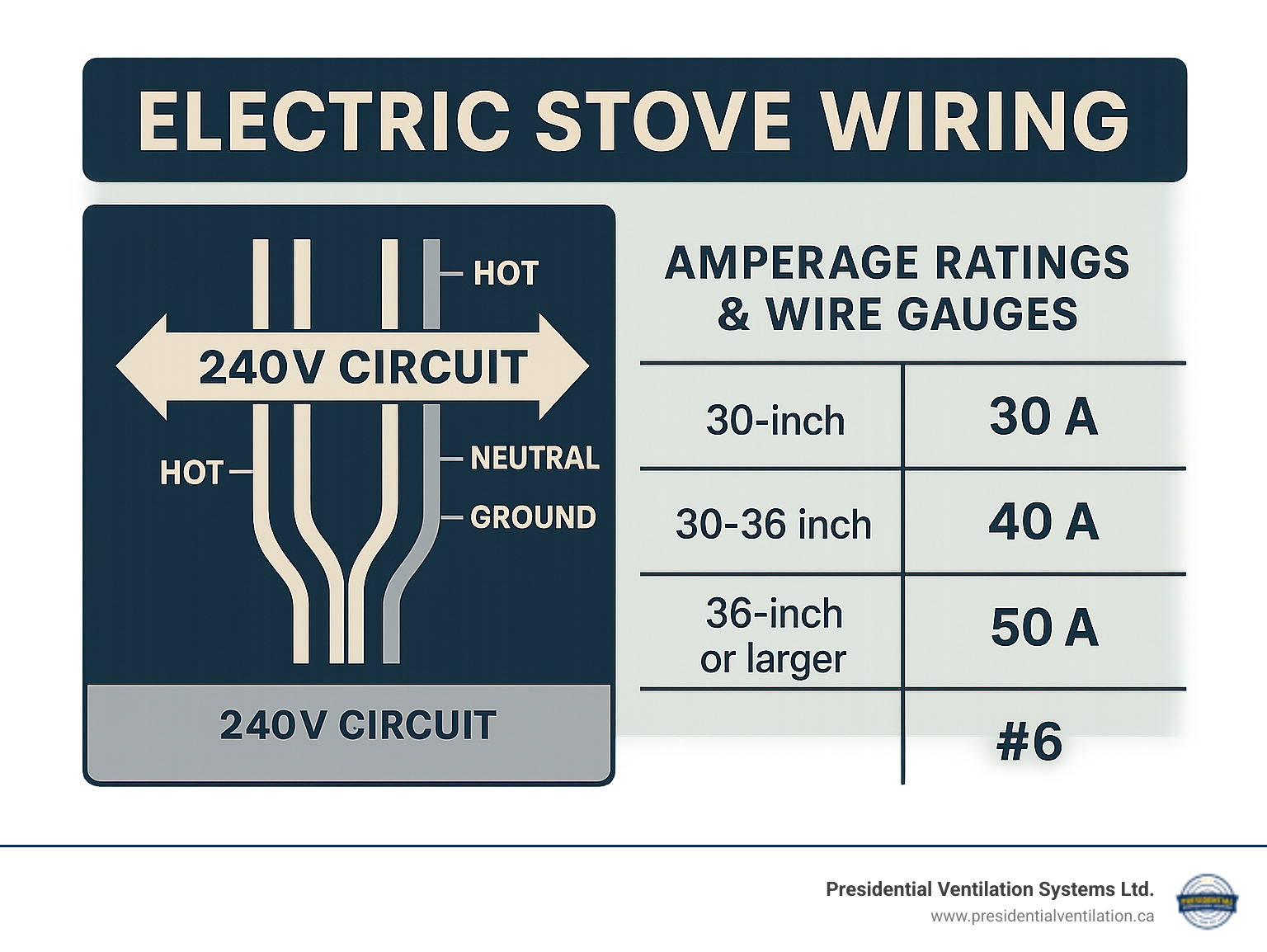
Powering an electric stove involves a significant electrical load, far greater than smaller appliances. Electric ranges are kitchen powerhouses, requiring a dedicated circuit that supplies both 120-volt and 240-volt currents. The 240V powers the heavy-duty heating elements for cooking, while the 120V handles lighter loads like clocks, timers, and lights.
This dual-voltage need makes stove wiring different from standard outlets. It requires a dedicated circuit from the main panel with specific amperage ratings, wire gauges, and a high-capacity circuit breaker. Most stoves draw 30 to 50 amps, so a robust electrical infrastructure is non-negotiable. If you have frequent tripped breakers, it might be a sign you need an Electrical Service Upgrade to safely handle the load.
Different electric ranges have unique wiring needs for a safe installation.
Unlike freestanding ranges, drop-in cooktops and wall ovens are usually hardwired directly to a junction box. This requires circuit conductors sized exactly to the appliance's nameplate rating, per the National Electrical Code (NEC). Always check the nameplate (usually on the back, side, or in a drawer) for precise voltage and amperage requirements to correctly size the circuit and wiring.
Understanding amperage and voltage is key. Electric ranges use a 120/240-volt circuit: two 120V "hot" lines combine for 240V to power heating elements, a neutral wire handles 120V components (clock, lights), and a ground wire ensures safety. Amperage requirements vary by stove:
Matching the circuit's amperage to your stove's needs is crucial to prevent overloading, which can cause tripped breakers and fire hazards. Always check the manufacturer's specifications for the exact amperage required.
Selecting the correct materials for electric stove wiring is paramount for safety and code compliance. Cutting corners can lead to fire and shock hazards. The National Electrical Code (NEC) sets strict standards to protect your home and family. The right wire size, outlet, and cable are critical for a safe installation. For a comprehensive overview, you might find A Guide To Wire Size and Types for Electric Stoves And Ovens to be a helpful resource.
One of the most significant changes in electric stove wiring over the years has been the evolution of the outlet and cord configuration.
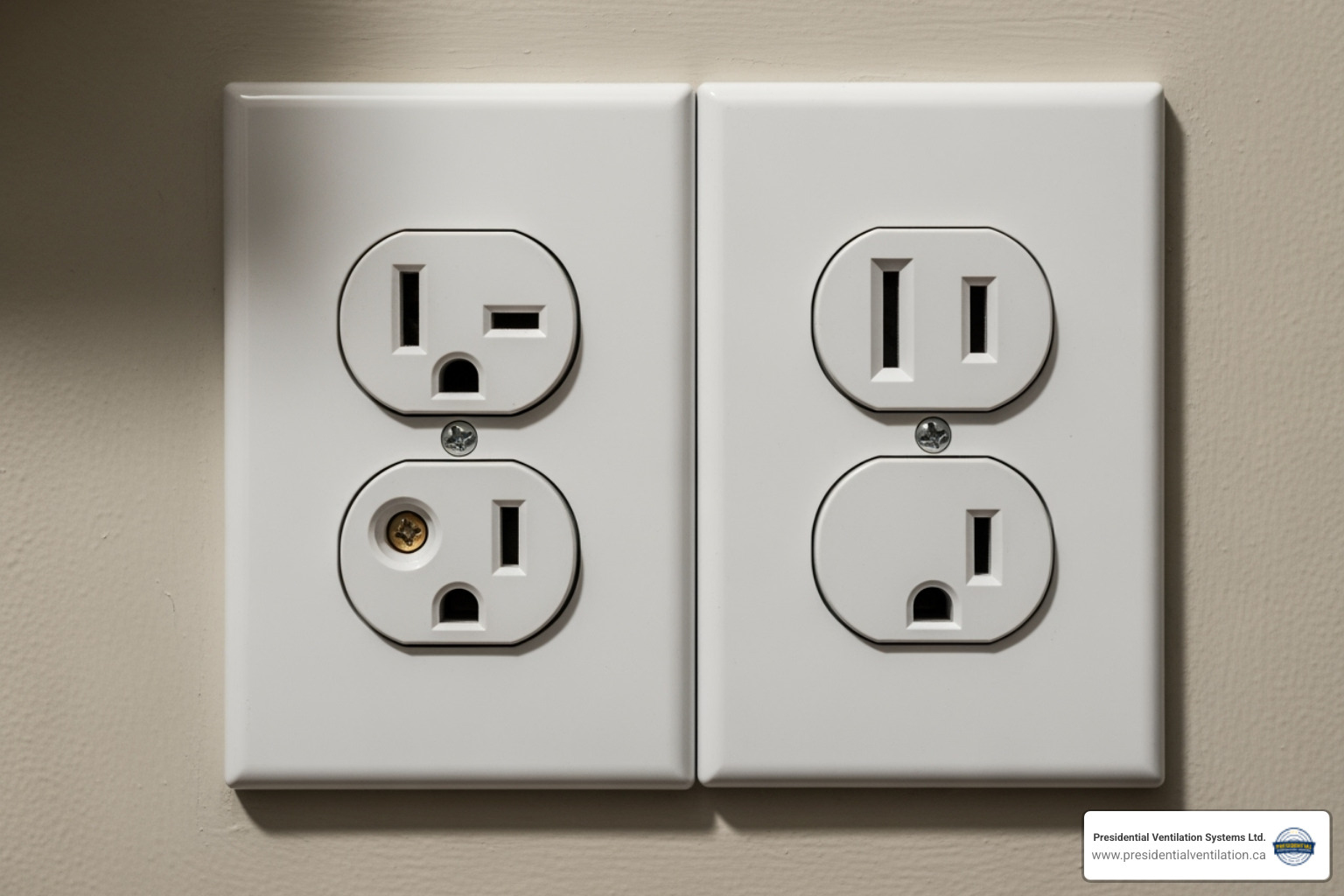
Historically, 3-prong outlets used a neutral wire that also served as the ground. This posed a shock hazard if the neutral wire failed, as the appliance's metal frame could become energized. To improve safety, the National Electrical Code (NEC) mandated 4-conductor circuits for all new installations since 1996. The 4-prong system includes a separate, dedicated ground wire, which provides an independent safety path and significantly reduces shock risk.
If your home has an existing 3-prong outlet, it's generally permitted to remain for an existing circuit. However, when installing a new range, you may need to switch the cord to a 3-prong version and follow the manufacturer's instructions to bond the neutral to the frame. For maximum safety, we always recommend upgrading to a 4-prong system whenever possible.
The wire gauge, or American Wire Gauge (AWG), refers to the thickness of the electrical wire. A lower AWG number indicates a thicker wire that can safely carry more current (amperage) without overheating. Using a wire that is too thin for the amperage it needs to carry is a major fire risk.
| Amperage (A) | Copper Wire Gauge (AWG) |
|---|---|
| 30 | 10 |
| 40 | 8 |
| 50 | 6 |
Note: These are general guidelines for typical residential applications. Always consult your appliance's nameplate and local electrical codes for precise requirements. For aluminum wire, a larger gauge (smaller AWG number) is generally needed for the same amperage due to its lower conductivity.
Beyond gauge, cable type is also important. The most common type for residential in-wall wiring is NM-B (Non-Metallic Sheathed) cable, often referred to by the brand name Romex. For ranges, you'll use 10/3, 8/3, or 6/3 NM-B cable. For exposed areas requiring more protection, individual THHN/THWN (Thermoplastic High Heat Nylon-coated/Thermoplastic Heat and Water resistant Nylon-coated) wires are often used within a protective conduit (either metal or PVC). This method is common in basements or garages. Always ensure your materials and installation method comply with local electrical codes.
Wiring an electric range can seem daunting, but it's a manageable task for many homeowners with the right preparation and safety protocols. However, electrical work carries inherent risks. If you're ever in doubt, please contact us for professional Electrical Hookup Services. Your safety is our priority. This guide focuses on connecting the power cord to the range, assuming a proper 240-volt circuit and receptacle are already installed.
Before you even think about touching wires, absolute safety is paramount.
Modern ranges are typically ready for a 4-prong connection, the safest standard.

If your home has an existing 3-slot receptacle, you'll need a 3-prong power cord and must pay careful attention to grounding.
While connecting to an existing 3-prong outlet might be permissible in older installations, it's generally considered less safe than a 4-prong system. If you have any doubts about handling a 3-prong connection, or if you're considering upgrading your outlet, please reach out to a qualified electrician.
Working with high-voltage electric stove wiring carries real risks of shock and fire if done incorrectly. A safe kitchen requires knowing what not to do. Minor errors, like using an undersized wire or miswiring, can cause fires or create shock hazards. Proper electrical work is critical in all settings, from homes to businesses needing Commercial Electrical Repairs, as safety principles are universal.
Here are some of the most frequent and dangerous mistakes we encounter with electric stove wiring:
While connecting a range cord can be a DIY task, many situations require a licensed electrician for safety and code compliance.
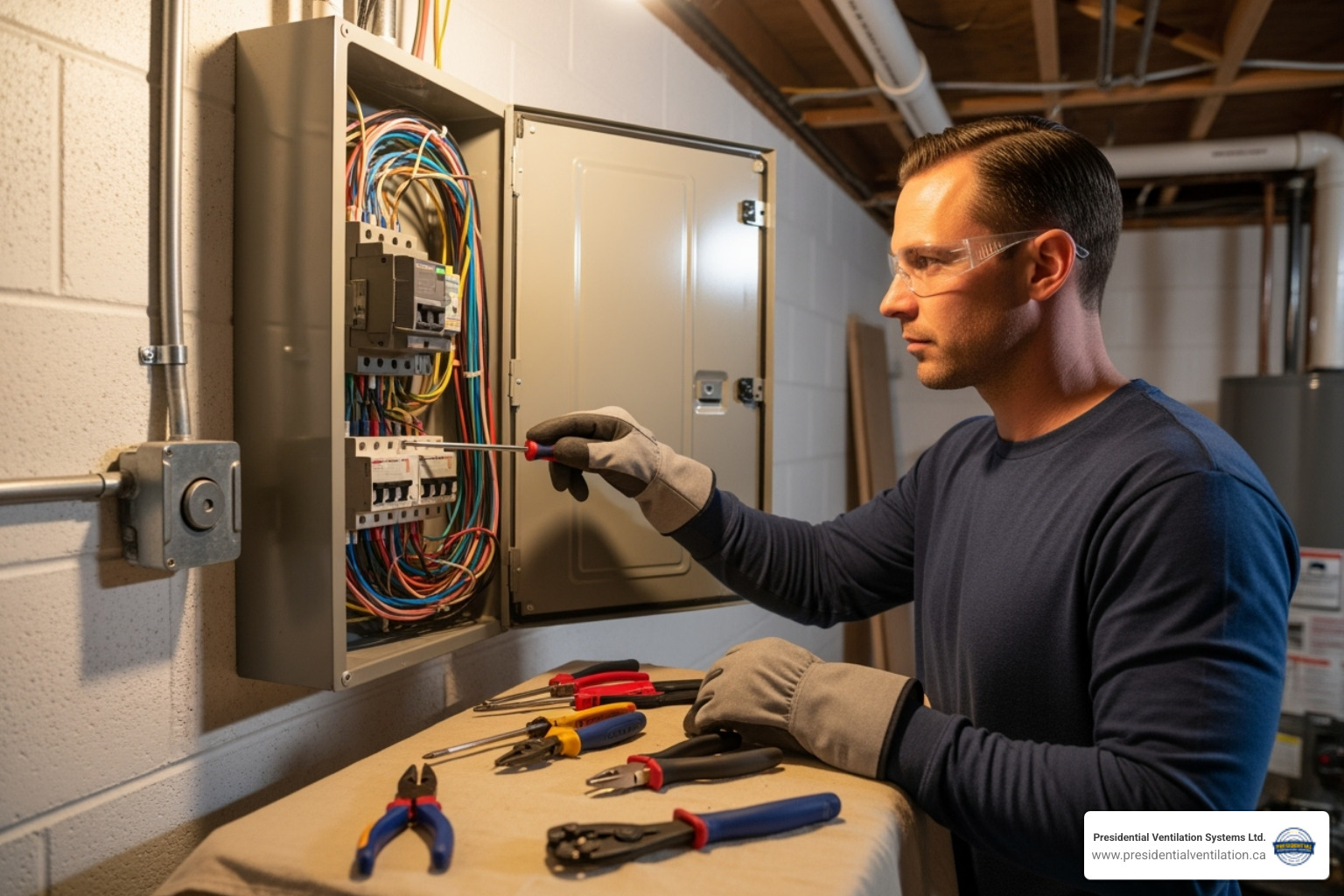
You should always call a licensed electrician if:
A licensed electrician ensures that your electric stove wiring is not only functional but also safe, compliant with all codes, and reliable for years to come.
We understand that electric stove wiring can be a complex topic with many nuances. Here are some frequently asked questions that we often encounter, providing clear and concise answers to help you steer your electrical needs.
The main difference is the connection method. Freestanding ranges use a plug-in cord and a dedicated receptacle, allowing for easy installation. Drop-in cooktops and wall ovens are typically hardwired directly into a junction box. For these hardwired appliances, the National Electrical Code (NEC) requires the circuit wiring to be sized exactly to the appliance's nameplate rating to ensure a stable power supply.
Since 1996, the National Electrical Code (NEC) has mandated 4-conductor circuits for new electric range installations to improve safety. This requires a 4-wire cord and a 4-prong outlet. Unlike older 3-prong systems where the neutral also acted as a ground, the 4-prong system has separate neutral and ground wires. This separation ensures the appliance's frame is always safely grounded, significantly reducing shock risk.
Electric ranges offer several advantages over gas:
These benefits make electric ranges a great choice for modern kitchens.
Navigating electric stove wiring is a critical step in ensuring your kitchen is not only functional but also safe and compliant with modern electrical standards. We've explored the essential requirements, from understanding amperage and voltage to choosing the right wire gauge and distinguishing between 3-prong and 4-prong outlets. We've also walked through the steps for connecting your range and highlighted common mistakes to avoid.
The importance of safety cannot be overstated when dealing with high-voltage appliances. Correct wiring is crucial not just for the immediate operation of your stove but also for the long-term longevity of your appliance and the overall safety of your home. It prevents overheating, reduces the risk of electrical fires, and protects against dangerous shocks.
Whether you're installing a brand-new range, upgrading an existing setup, or simply have questions about your home's electrical capacity, professional expertise is invaluable. For professional and safe installations in Nova Scotia, trust the experts at Presidential Ventilation Systems Ltd. We're dedicated to ensuring your electrical systems are up to code and perfectly suited for your needs.
Ensure your kitchen is powered correctly and safely by contacting us for Electrical Services in Halifax, NS. We proudly serve communities across Nova Scotia, including Kentville NS, Truro NS, Mount Uniacke NS, Dartmouth NS, Bridgewater NS, Bedford NS, and Windsor NS, providing reliable electrical solutions for all your residential and commercial needs.


An oil to heat pump upgrade in Halifax NS is one of the most popular home improvements for Nova Scotians. The switch is about smarter energy use, lower bills, and year-round comfort. Here are the key benefits of upgrading:
Halifax's climate makes this transition particularly attractive. Modern cold-climate heat pumps work efficiently even when temperatures drop well below freezing, and government programs like the Oil to Heat Pump Affordability (OHPA) Program make the investment more accessible than ever.
With oil prices fluctuating and environmental concerns growing, more than 10,000 Nova Scotians have already applied for heat pump conversion programs. The transition has reduced greenhouse gas emissions by thousands of metric tonnes while putting money back in homeowners' pockets.
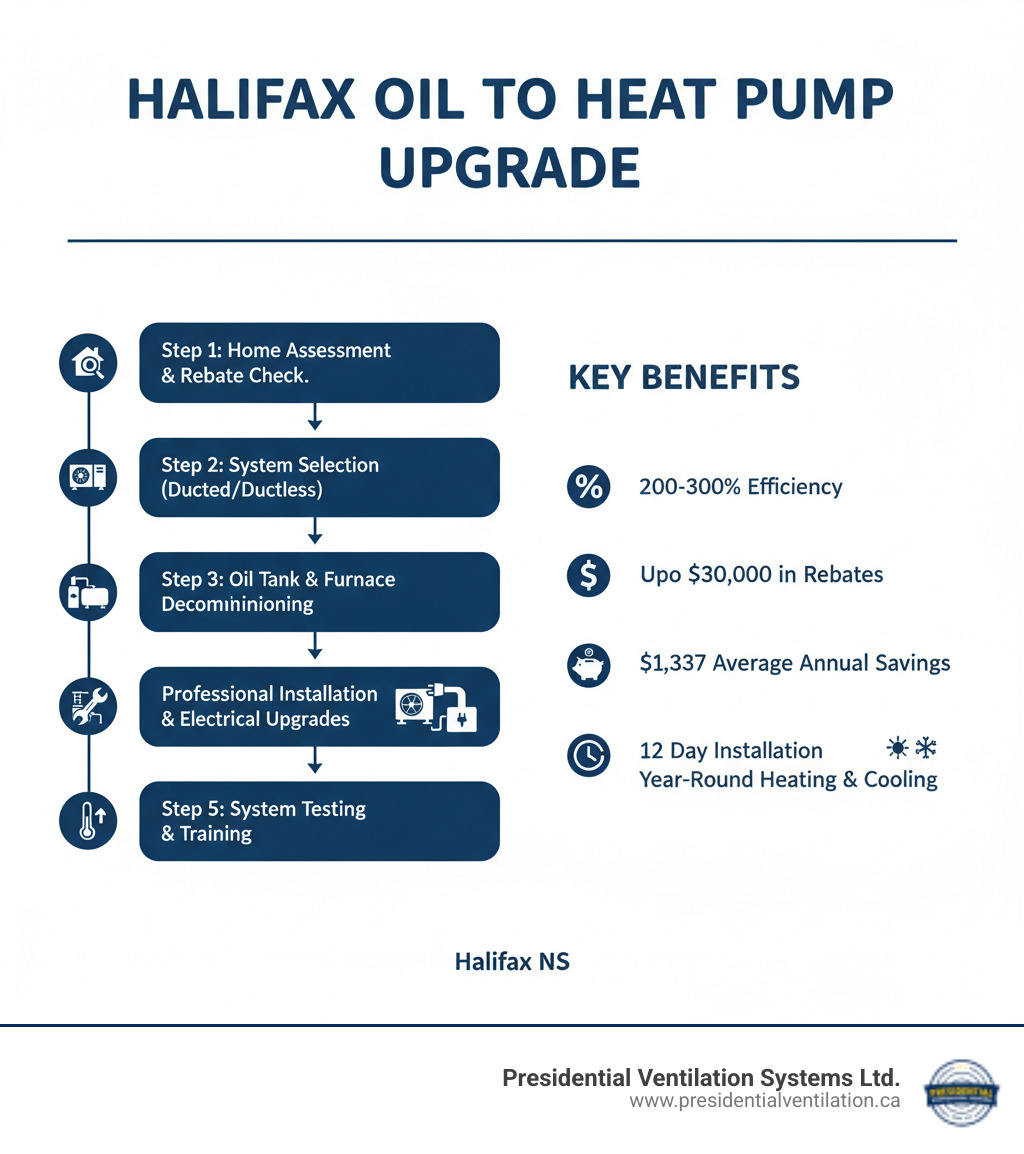
At Presidential Ventilation Systems Ltd., we have over 30 years of experience helping Halifax families make the switch, enhancing their comfort and reducing energy expenses. We guide you through every step of your oil to heat pump upgrade in Halifax NS.
Traditional oil furnaces operate at 65-85% efficiency, meaning a significant portion of energy is lost as waste heat. In contrast, heat pumps don't generate heat—they transfer it. In winter, they extract heat from the outside air and move it indoors. In summer, they reverse the process for cooling. This allows heat pumps to achieve 200-300% efficiency ratings. For every unit of electricity consumed, they deliver two to three units of heating or cooling.
This efficiency means heat pumps can use up to 70% less energy than oil heating systems. Modern cold-climate air source heat pumps are designed to operate efficiently even when temperatures drop significantly below freezing. To learn more, you can learn about heat pump efficiency in extreme temperatures.
An oil to heat pump upgrade in Halifax NS offers substantial long-term savings and a positive environmental impact. Homeowners can save up to 50% on heating costs, with an average of $1,337 saved annually. Since heat pumps also provide cooling, you eliminate the need for a separate air conditioning unit, leading to more year-round savings.
Environmentally, switching from a fossil-fuel-burning oil furnace to an electric heat pump eliminates combustion and drastically reduces your home's carbon footprint. This transition can cut a household's emissions by almost 3 tonnes annually. For a deeper dive, explore the environmental benefits of upgrading your furnace.
Here's a quick comparison:
| Feature | Oil Furnace | Heat Pump |
|---|---|---|
| Efficiency (%) | 65-85% | 200-300% |
| Annual Savings | Fluctuating | Up to 50% (Avg. $1,337) |
| Environmental | High CO2 emissions | Low/Zero CO2 emissions* |
| Cooling Capability | None | Yes |
| Maintenance | Frequent (soot, filters) | Less frequent (filters, check-ups) |
| Fuel Source | Fossil Fuel | Electricity |
*Depends on electricity source. Nova Scotia is increasingly integrating renewable energy into its grid.
For more details on making the switch, check out our guide on more info about switching to a heat pump.

An oil to heat pump upgrade in Halifax NS is more affordable than you might think, thanks to generous government programs. Federal and provincial initiatives like the Oil to Heat Pump Affordability (OHPA) Program and Efficiency Nova Scotia offer eligible Halifax residents combined funding of up to $30,000.
These programs are designed to remove financial barriers, with the average grant for heat pump installation sitting around $7,158. This can significantly reduce your out-of-pocket expenses and help you move toward a cleaner, more efficient heating solution.
Navigating rebate programs can be complex, but we're here to help. To find out what rebates you qualify for and how we can guide you through the application process, visit our page on heat pump rebates in Halifax NS.
The Oil to Heat Pump Affordability (OHPA) Program is a game-changer for Halifax homeowners. This federal program, delivered in Nova Scotia through Efficiency Nova Scotia, targets low- and median-income households who need financial support to switch from oil.
The program provides up to $15,000 in funding to cover a comprehensive range of costs. This includes the new cold-climate heat pump and its installation, necessary electrical upgrades, and the safe removal of your old oil tank. It can also cover supplemental electric heating systems and the switch of other oil-using appliances like water heaters.
A key feature is the availability of upfront payments for eligible customers. This means funding can go directly to your contractor, so you don't have to pay thousands out of pocket and wait for reimbursement. Some programs also include complimentary energy-efficiency upgrades like LED lighting and smart thermostats.
To explore the full details, we encourage you to learn more at the official OHPA Program page.
Eligibility for Nova Scotia grants like the OHPA program is straightforward. Here are the main requirements:
Before applying, gather your Notice of Assessment, a Nova Scotia Power bill, proof of home ownership, and oil purchase receipts to make the process smoother.
While the Canada Greener Homes Grant is no longer accepting new applications, the OHPA program remains a fantastic opportunity. You might also qualify for an interest-free loan of up to $40,000 from the Canada Mortgage and Housing Corporation (CMHC) for additional upgrades. You can check your eligibility for the Canada Greener Homes Loan for more information.
Understanding the process is the next step after deciding to switch from oil to a heat pump. At Presidential Ventilation Systems Ltd., we make your oil to heat pump upgrade in Halifax NS as smooth as possible. Our certified professionals manage every detail, from the initial assessment to final testing.
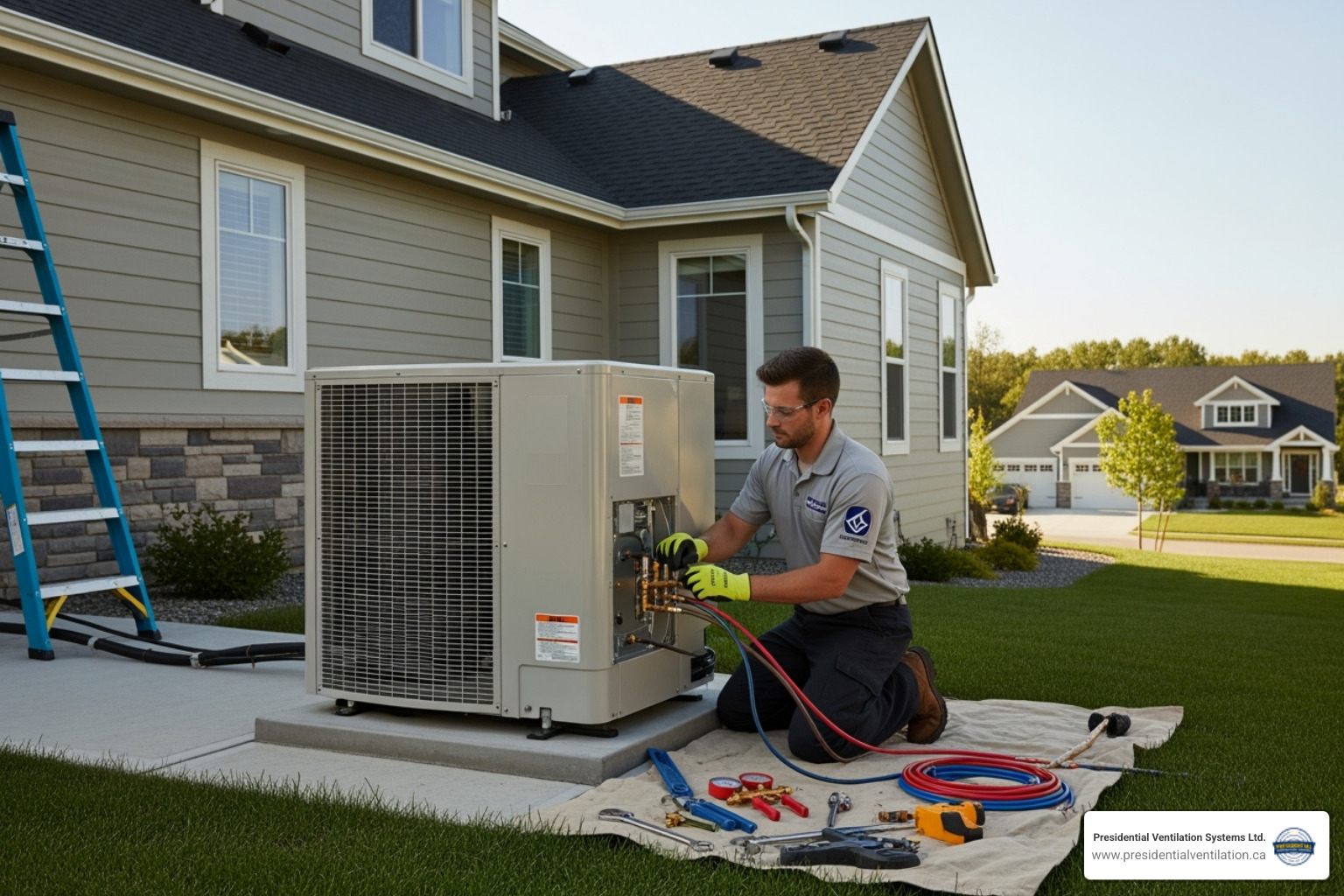
With over 30 years of experience, we've refined the conversion process to take the guesswork out of your hands. To see how we deliver top-tier service, view our heat pump installation services in Halifax.
Converting from oil to a heat pump is a straightforward process with the right team. Most installations are completed in just 1-2 days, minimizing disruption. The process includes:
Halifax's climate demands a system that can handle both cold winters and humid summers. Modern cold-climate heat pumps are designed for this, with some models operating effectively down to -30°C.
When planning your oil to heat pump upgrade in Halifax NS, you'll choose between two main types:
Ducted Heat Pumps: Ideal for homes with existing ductwork, these systems provide consistent, whole-home heating and cooling by integrating with your current setup. They offer a familiar feel with superior efficiency. You can explore our ducted heat pump systems to learn more.
Ductless Mini-Split Heat Pumps: Perfect for homes without ductwork or for zoned climate control. An outdoor unit connects to one or more indoor units, allowing independent temperature control in different rooms for improved comfort and energy savings. Read our ductless heat pump Halifax guide for a comprehensive look.
Proper sizing is critical. An incorrectly sized unit will operate inefficiently and wear out prematurely. Our experts perform detailed calculations to ensure your system is perfectly matched to your home.
One of the benefits of an oil to heat pump upgrade in Halifax NS is simpler maintenance. Oil furnaces require frequent cleaning of soot and residue, along with filter changes and annual tune-ups to prevent breakdowns. Heat pumps, on the other hand, are much less demanding.
Heat pump maintenance is straightforward:
Overall, heat pump maintenance is simpler and generally less expensive than for an oil furnace, but regular care is key to protecting your investment for 15-20 years or more. To keep your system running smoothly, schedule your heat pump maintenance in Halifax with our team.
Choosing the right professional for your oil to heat pump upgrade in Halifax NS is crucial, as the quality of the installation determines your system's performance and longevity. Here’s what to look for in an HVAC partner:
At Presidential Ventilation Systems Ltd., we bring all these qualities to every project. We're not just installing equipment—we're partnering with you to create a more comfortable and efficient home. To see how we can help, see our comprehensive HVAC services in Halifax.
It's natural to have questions when considering a major home project like an oil to heat pump upgrade in Halifax NS. Here are answers to some of the most common questions we receive.
Yes, a modern cold-climate heat pump will absolutely keep your home warm and comfortable throughout a Halifax winter. These systems are specifically engineered to perform in freezing temperatures, with many models operating efficiently down to -25°C or -30°C. Even at -18°C, the air still contains 85% of the thermal energy found at 21°C, and heat pumps are designed to extract this energy. For rare instances of extreme cold, a supplemental electric heating source can be integrated as a backup, ensuring you always have the heat you need. For more on this, read our guide: Do I need a backup source of heat?.
Professional decommissioning and removal of your old oil furnace and tank is a standard part of a complete oil to heat pump upgrade in Halifax NS. Our certified technicians manage this process safely and in compliance with all environmental regulations. Any remaining oil is removed, the tank is cleaned, and both the furnace and tank are removed from your property for responsible disposal. The cost of this service is often covered by government rebate programs like the Oil to Heat Pump Affordability (OHPA) Program, making the transition seamless and affordable.
The physical installation of your oil to heat pump upgrade in Halifax NS is surprisingly quick. While the overall process includes an assessment and planning phase for system selection and rebate applications, the actual installation typically takes just 1 to 2 days. The exact timeline depends on the system type (ducted or ductless) and whether electrical upgrades are needed. Our technicians work efficiently to minimize disruption to your daily life. After installation, we conduct thorough system testing and walk you through its operation to ensure you are completely comfortable with your new system.
An oil to heat pump upgrade in Halifax NS is a smart investment in your home's comfort and efficiency. You gain a system that operates at 200-300% efficiency, saving an average of $1,337 annually on heating costs. You also get the year-round benefit of heating and cooling from a single, reliable unit.
By eliminating fossil fuel combustion, you'll reduce your household's CO2 emissions by nearly 3 tonnes each year, contributing to a greener Halifax. With up to $30,000 in combined rebates available through programs like the OHPA Program, this upgrade is more accessible than ever.
At Presidential Ventilation Systems Ltd., we have over 30 years of experience helping Halifax families make this transition. Our certified experts handle everything, from the initial assessment and rebate applications to the safe removal of your old oil tank and professional installation of your new system. As a leading Daikin Comfort Pro Dealer, we back our work with exceptional service and comprehensive warranties.
You've lived with fluctuating oil prices long enough. It's time for a more comfortable, efficient, and sustainable home. Trust the team that Halifax homeowners have relied on for decades.
Ready to transform your home's comfort and start saving? Contact us to discuss your furnace replacement in Halifax NS today. We're here to help you make the switch with confidence.
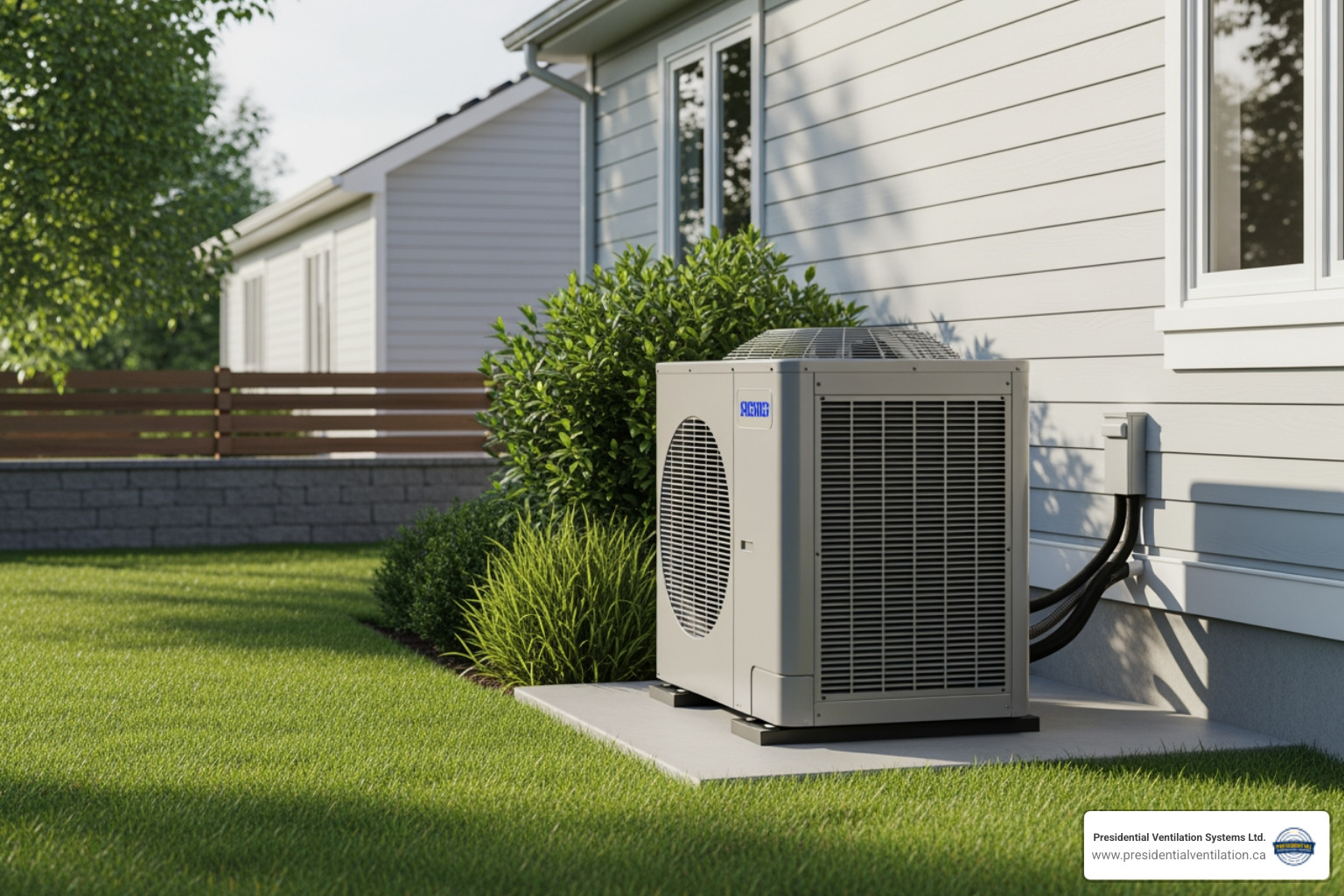

The fan on my outdoor heat pump unit stopped working. Who does heat pump fan replacement near Timberlea? If you're facing this problem, you need a qualified refrigeration technician to diagnose and replace the failed fan motor safely. In Timberlea and the Halifax Regional Municipality, certified HVAC professionals service major heat pump brands, including Daikin, Fujitsu, Mitsubishi, and Lennox. A broken outdoor fan is a serious issue that can cause your compressor to overheat and fail, turning a simple repair into an expensive replacement.
Quick Answer: Who Can Help You Now
For comprehensive information on heat pump systems, visit our Heat Pumps Halifax NS page, or get immediate help by contacting our Heat Pump Service team.
A non-working outdoor fan is a common but critical issue that can stop your heat pump from heating or cooling your home. This guide covers the signs, causes, and solutions for homeowners facing this problem.
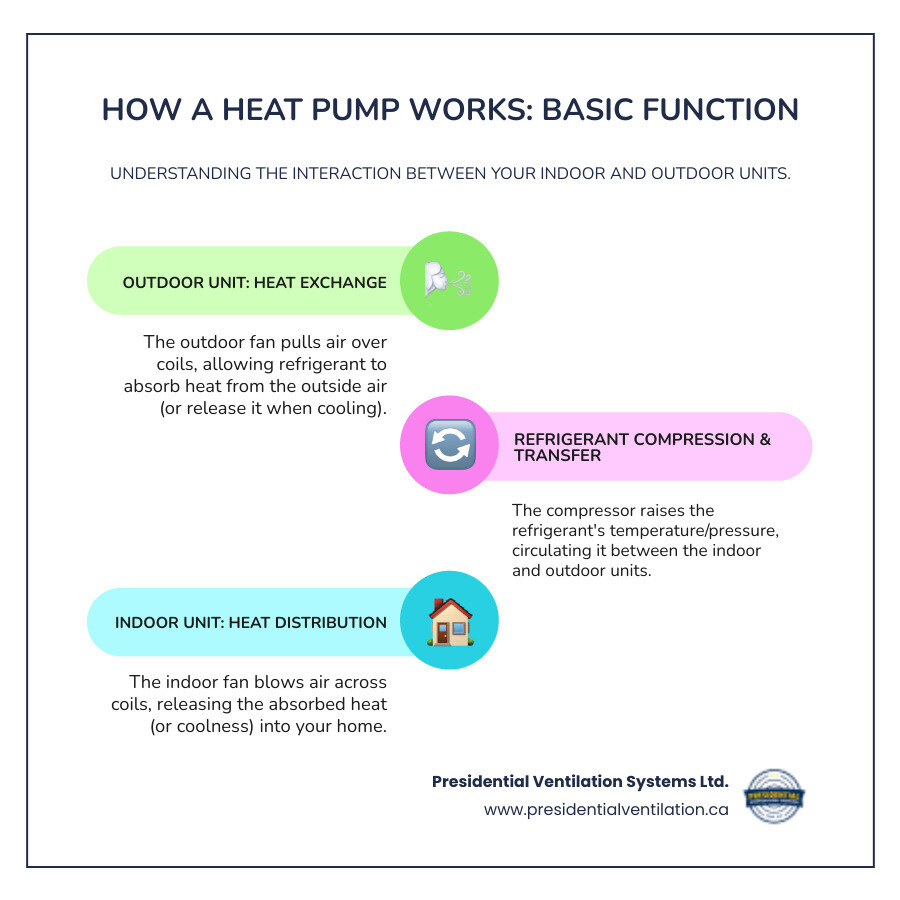
When the fan on your outdoor heat pump unit stopped working, your system can't function correctly. The good news is that your heat pump usually provides warning signs before a complete failure. Catching these early can prevent a minor issue from becoming a major repair.
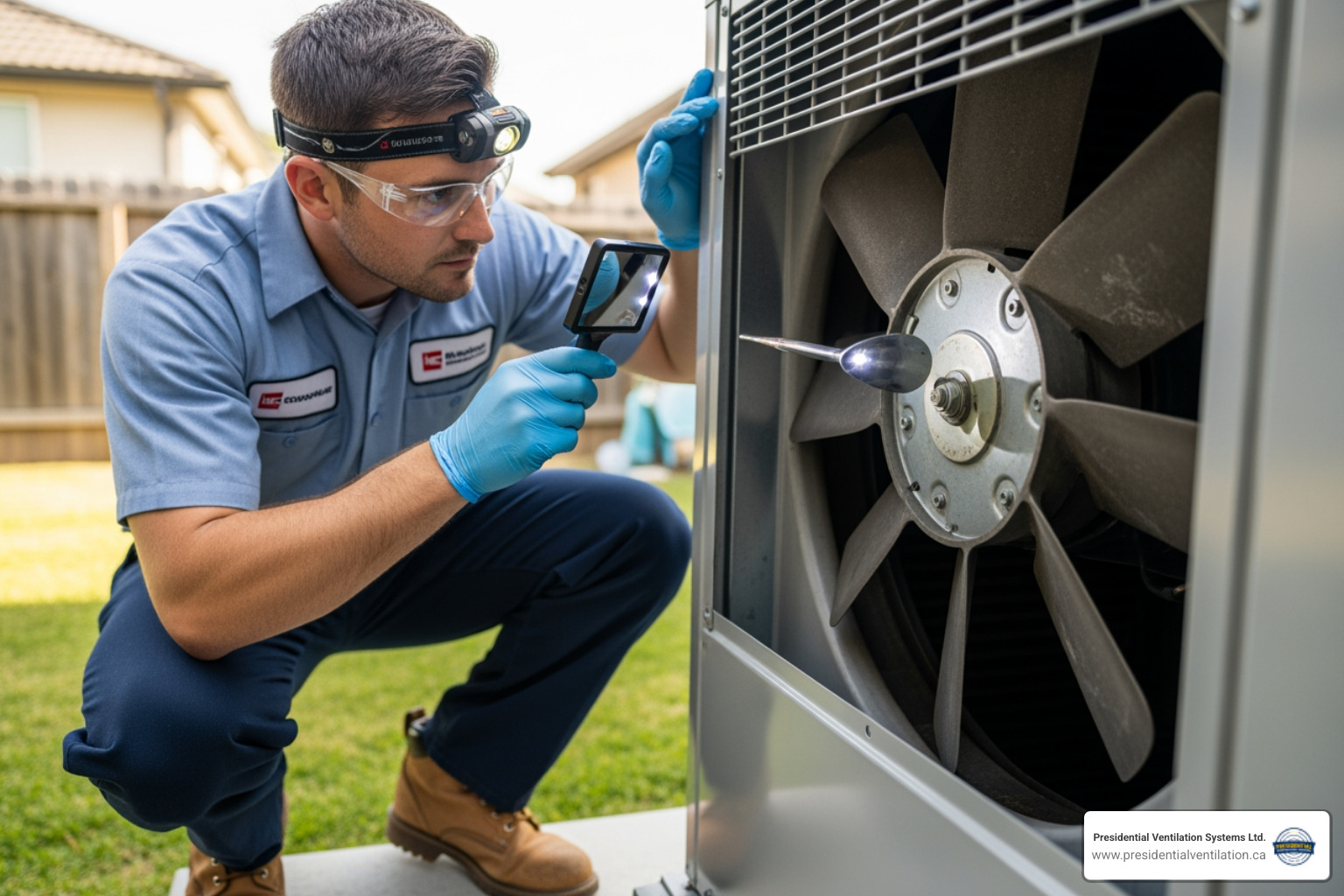
The most obvious sign is that your fan blades aren't spinning. If the unit is making noise but the blades are still, you have a problem. You might also notice your unit humming but the fan remaining motionless. This sound is often the compressor trying to run without the critical airflow the fan provides.
Another sign is that your system might start frequently shutting down. This is a safety feature to prevent overheating. When the fan doesn't spin, the unit gets too hot and shuts down to protect itself. In colder weather, you might see ice buildup on your outdoor coils. Without airflow from the fan, the unit can't defrost properly, causing ice to accumulate rapidly.
The impact on your comfort is unmistakable: inadequate heating or cooling. The indoor unit may blow air, but it won't be at the right temperature because the heat exchange process has stopped. Before the fan fails completely, you might hear strange noises like grinding, squealing, or rattling. These are signs of mechanical issues, such as worn bearings, warning you that a failure is imminent.
If you notice any of these symptoms, especially a stationary fan, don't wait. The longer you delay, the more damage your system can sustain. For more information, see our guide on Signs Heat Pump Needs Immediate Attention.
Your outdoor fan motor works hard year-round. Eventually, components can fail.
Understanding these causes highlights the importance of regular maintenance. For more insight, check out our articles on Top Reasons Heat Pumps Fail and Common Heat Pump Issues.
A heat pump running without its fan is like a car engine running without coolant—catastrophic damage can happen quickly. Before you consider a DIY fix to save money, it's crucial to understand the risks involved.
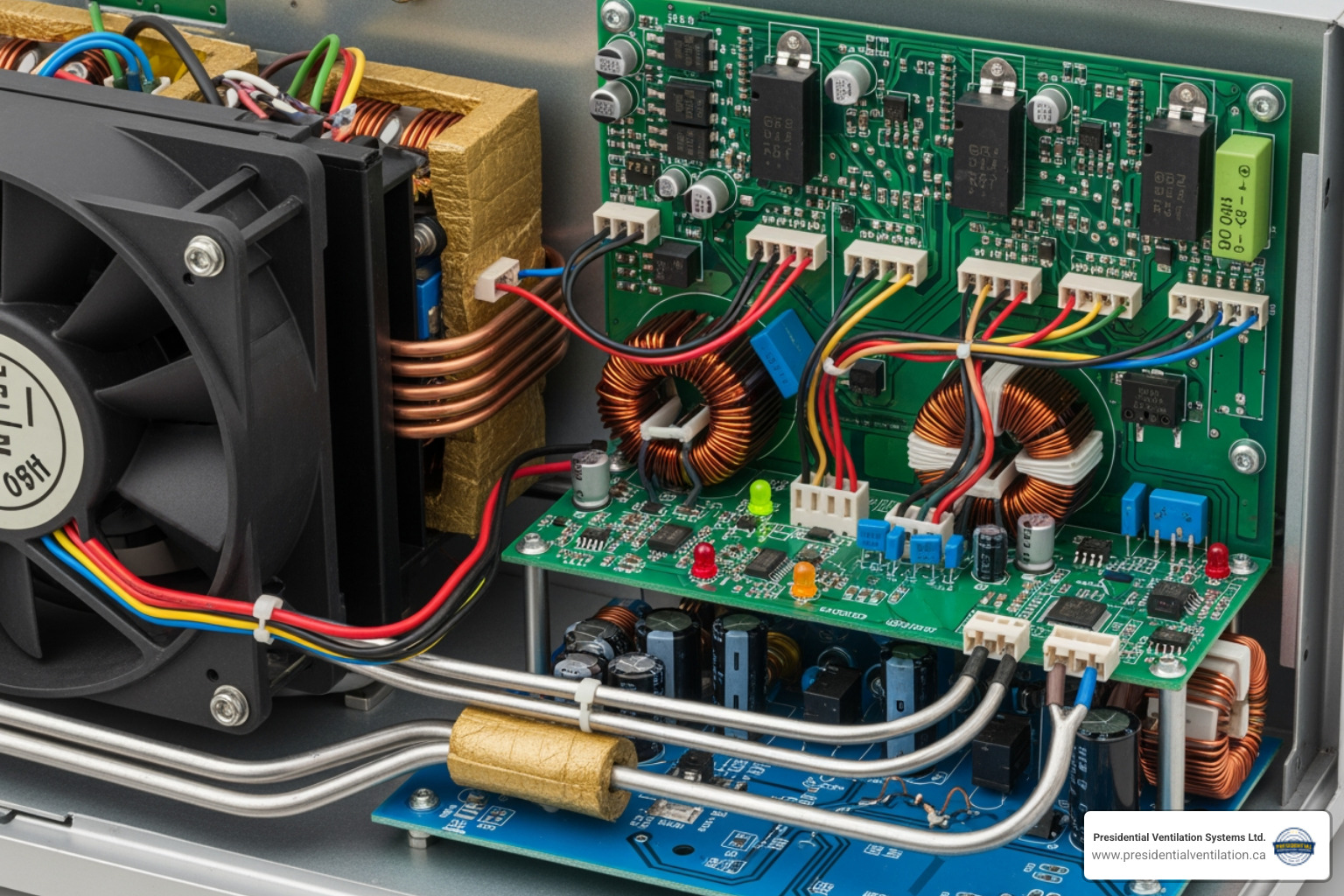
The outdoor fan is essential for your heat pump's survival. When it stops, your system enters a danger zone.
Compressor overheating and failure is the most critical risk. The fan's job is to pull air over the coils to dissipate heat. Without it, the compressor—the heart of your system—quickly overheats. This leads to permanent internal damage. Replacing a failed compressor is one of the most expensive heat pump repairs, often approaching the cost of a new outdoor unit.
This leads to complete system failure, leaving you with no heating or cooling. The extreme temperatures also put immense pressure on refrigerant lines, potentially causing leaks. Furthermore, the constant overheating and shutting down stresses other electrical components like relays and control boards, turning a single problem into a system-wide failure.
The bottom line: running your heat pump with a broken fan is a costly gamble. Shut down your system immediately if the fan on your outdoor heat pump unit stopped working. For more guidance, visit our Heat Pump Troubleshooting Call Our Technicians page.
Replacing a heat pump fan motor is more complicated and dangerous than it appears. Here’s why a professional repair is the smart choice.
DIY Risks:
Professional Service Benefits:
For a critical system like your heat pump, professional service is the only choice that protects your investment and ensures your safety. Learn more in our Heat Pump Fan Replacement Complete Guide.
When your outdoor heat pump fan fails, you need a fast, reliable solution. At Presidential Ventilation Systems Ltd., we have over 30 years of experience helping homeowners in Timberlea and throughout Nova Scotia. We understand the urgency when the fan on your outdoor heat pump unit stopped working and are here to provide expert service.
Grinding, squealing, or rattling sounds are urgent warning signs. They are your system's cry for help before a complete breakdown.
Turn the system off immediately at the breaker to prevent further damage. This is the most important step you can take. Do not just turn off the thermostat; cut all power at your electrical panel. Once the system is safely off, give the unit a quick visual check for obvious obstructions like branches or heavy ice, but do not attempt any repairs yourself.
As soon as the system is secured, schedule a Heat Pump Service appointment. The sooner a professional diagnoses the issue, the better the chance of avoiding a catastrophic compressor failure.
Our comprehensive service is designed to restore your system to peak performance. Here’s our process:
Servicing a heat pump requires specialized knowledge. Here’s what to look for:
When your heat pump fan gives out, finding a qualified technician in your area is key. You need prompt, professional service from someone who knows your heat pump brand and can get to you quickly.
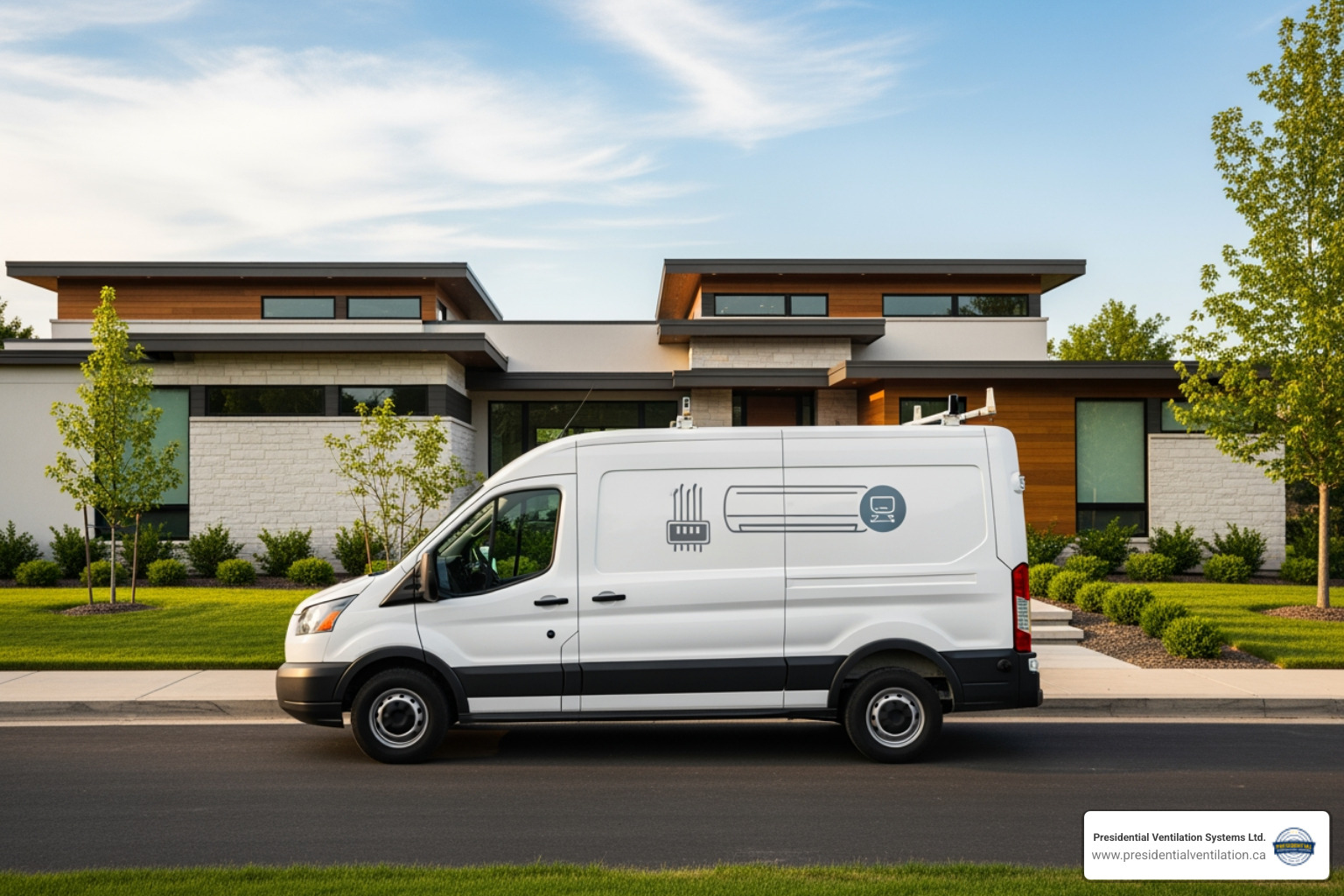
An experienced HVAC service provider can handle most heat pump brands. Our technicians are proficient in servicing and repairing fan issues for virtually all major makes and models, ensuring we can help no matter what system you have.
We regularly service Daikin, Fujitsu, LG, Mitsubishi, Lennox, and Goodman systems. We also work on York, Moovair, Tosot, GE, Direct Air, Novair, Samsung, Panasonic, Rudd, Trane, Carrier, Rheem, Bryant, and Amana units. Our breadth of expertise means we have the knowledge and access to the right parts to repair your specific unit correctly and reliably.
While your immediate concern is "The fan on my outdoor heat pump unit stopped working. Who does heat pump fan replacement near Timberlea?", our service area extends throughout the Halifax Regional Municipality and surrounding communities.
We regularly serve homeowners in Timberlea, Halifax, Dartmouth, Lower Sackville, Middle Sackville, Upper Sackville, Clayton Park, Beaver Bank, Bedford, Cole Harbour, Eastern Passage, Fall River, Tantallon, Lawrencetown, Waverley, and Mount Uniacke. We also reach communities like Indigo Shores, Lacasville, Prospect, Hubbards, Sambro, Herring Cove, Hatchet Lake, Williamswood, East Dover, Indian Harbour, Spryfield, Otter Lake, Fairview, Terence Bay, Porters Lake, Preston, Peggys Cove, Harrietsfield, Woodlawn, Shearwater, and Burnside.
Whether you need Heat Pump Repair Halifax NS, Heat Pump Repair Dartmouth NS, Heat Pump Repair Mount Uniacke NS, or HVAC Services Bedford NS, our team is ready to bring our expertise to your doorstep.
While some fan failures are due to age, many can be avoided or delayed with proactive care. Preventative maintenance is the best way to keep your outdoor fan motor running reliably.
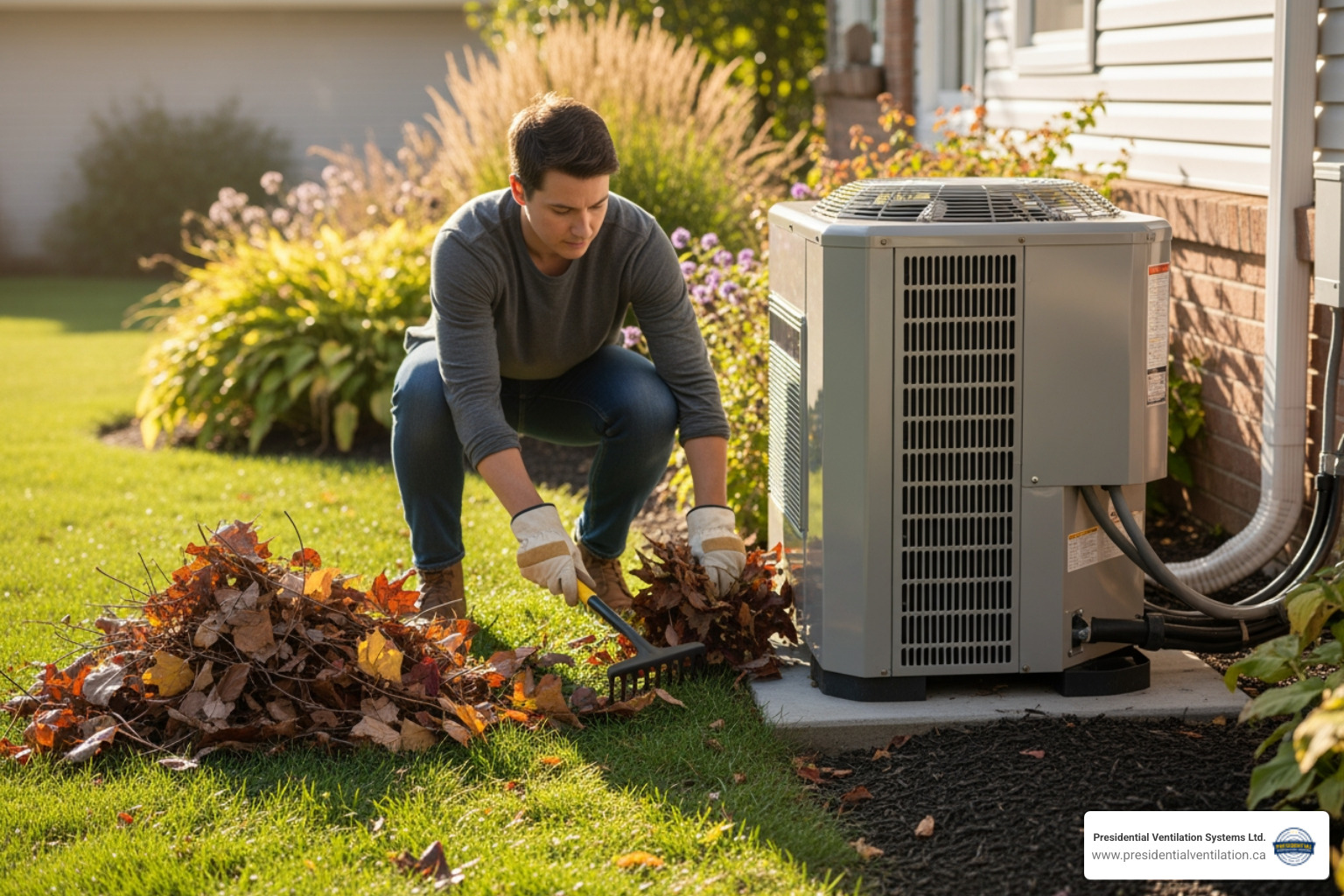
Yes, regular upkeep is key to extending the life of your heat pump's outdoor fan motor and preventing unexpected breakdowns.
Here are our top preventative maintenance tips:
Regular professional maintenance improves efficiency, extends your heat pump's lifespan, and helps prevent costly repairs. It’s an investment in comfort and savings. For more details, read our blog on Why Heat Pump Maintenance Is Essential and consider booking an Annual Heat Pump Tune-Up. You can also learn about services in your area, like Heat Pump Maintenance Halifax NS.
A broken heat pump fan is an urgent problem. The fan on my outdoor heat pump unit stopped working. Who does heat pump fan replacement near Timberlea? If you're asking this, you've come to the right place. Attempting a DIY repair is risky and can lead to more expensive damage, such as a failed compressor.
The safest, most effective solution is to contact a qualified professional. You need an expert who can diagnose the problem accurately, source the correct parts, and complete the repair safely.
At Presidential Ventilation Systems Ltd., we understand the vital role your heat pump plays in your home's comfort. With over 30 years of experience serving homeowners throughout the Halifax Regional Municipality, our Red Seal Certified refrigeration mechanics provide expert service for all major heat pump brands, from Daikin and Fujitsu to Mitsubishi, Lennox, and beyond.
When you choose us, you're choosing proper part sourcing, expert installation by certified professionals, and thorough system testing. We don't just replace a part; we ensure your entire system operates at peak efficiency, protecting your investment.
Don't let a non-working fan compromise your comfort or lead to catastrophic damage. For expert diagnosis and reliable Heat Pump Repair in Timberlea NS, trust the certified technicians at Presidential Ventilation Systems Ltd. to restore your home's comfort quickly and safely. Whether you're in Timberlea or need service for your Heat Pumps in Halifax NS, we're here to help.
Contact us today and let us take the stress out of your heat pump repair. We're here to help you stay comfortable, season after season.